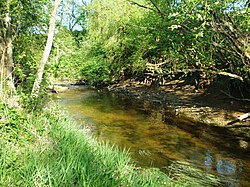The Barupė is a river in Jonava District Municipality and Kėdainiai District Municipality of Kaunas County, in central Lithuania. It flows for 48.2 kilometres (30.0 mi) and has a basin area of 322 square kilometres (124 sq mi). It is a left tributary of the Nevėžis.
| Barupė | |
|---|---|
 Barupė in Pabarupys | |
| Location | |
| Country | Lithuania |
| Region | Kaunas County |
| Physical characteristics | |
| Source | |
| • location | Nearby Žinėnai, Jonava District Municipality |
| Mouth | Nevėžis in Labūnava |
• coordinates | 55°12′13″N 23°54′20″E / 55.2036°N 23.9056°E |
| Length | 48.2 km (30.0 mi)[1] |
| Basin size | 322.4 km2 (124.5 sq mi)[1] |
| Discharge | |
| • average | 1.55 m³/s[2] |
| Basin features | |
| Progression | Nevėžis→ Neman→ Baltic Sea |
| Tributaries | |
| • left | Savyda, Mėkla, Urka |
| • right | Kulvė, Vabalas, Paparčia |
The Barupė starts at Žinėnai village, in Jonava District Municipality. It flows northwards, before turning to the west in Pamelnytėlė. It meets the Nevėžis near Labūnava village.[2]
The upper course in channalised. The lower course has a deep valley. The course has a width of 5–12 metres (16–39 ft) and depth of 0.1–0.4 metres (3.9 in – 1 ft 3.7 in). The flow rate is 0.1–0.2 metres per second (0.33–0.66 ft/s). Labūnava Reservoir dams the Barupė river; smaller ponds are also located in the Barupė valley in Kuigaliai and Labūnava.[2]
Sangailiškiai, Kuigaliai, Pėdžiai, Nociūnai, Serbinai, Labūnava villages are located on the shores of the Barupė. A part of river's lower course is protected as the Barupė Landscape Sanctuary.
The hydronym is of uncertain origin. The component upė means 'river' while the root bar- could be of archaic origin, related to Russian: бара 'puddle', Ukrainian: бар 'slough between hills', Illyrian languages: *bar(b)- 'puddle'.[3]
References edit
- ^ a b B. Gailiušis, J. Jablonskis, M Kovalenkovienė (2001). Lietuvos upės (in Lithuanian). Kaunas: Lietuvos energetikos institutas. p. 507.
{{cite book}}: CS1 maint: multiple names: authors list (link) - ^ a b c Tarybų Lietuvos enciklopedija (in Lithuanian). Vol. 1. Vilnius: Vyriausioji enciklopedijų redakcija. 1985. p. 216.
- ^ Vanagas, Aleksandras (1981). Lietuvių hidronimų etimologinis žodynas (in Lithuanian). Vilnius: Mokslas.